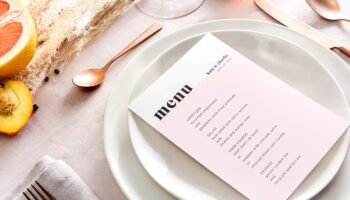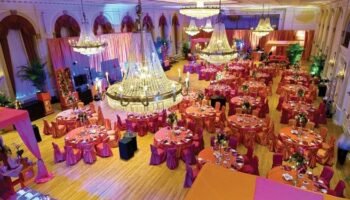
The aroma of delicious food, the clinking of glasses, and the sound of laughter encapsulate the essence of a wedding feast. But one question that many soon-to-be-wed couples grapple with is: “Do you need wedding menus?” While it may seem like a minor detail in the grand scheme of things, the choice can influence the overall guest experience. In this comprehensive guide, we dive deep into the necessity and impact of wedding menus.
A wedding menu stands as a testament to the gastronomic experience awaiting guests. Beyond its basic function of listing dishes, it captures the essence of the culinary journey that the couple wishes to share. This curated journey, be it through a lavish multi-course meal or a simple yet heartfelt spread, reflects not just the couple’s taste but their story, values, and the memories they cherish. The style of the menu, whether steeped in modern minimalism or rich traditions, adds layers to this narrative. It subtly offers insights, making the menu not just a guide, but a conversation starter, painting a vivid picture of the hosts’ personalities and passions.
Wedding menus, often viewed as a simple list of what’s to be served, play a far more significant role in shaping the overall experience of your celebration. Let’s delve deeper into why they’re more than just an afterthought:
Beyond its functional role, a wedding menu becomes an extension of the event’s theme and storytelling. A meticulously crafted menu can seamlessly blend with the wedding’s ambiance. Whether it’s the elegance of a vintage soirée, the earthy charm of a rustic gathering, or the sleek sophistication of a contemporary celebration, the design, wording, and presentation of the menu can echo these nuances. It doesn’t just inform; it immerses, inviting guests to revel in the cohesive aesthetic experience that the couple has envisioned and brought to life. Through typography, materials, and layout, a menu can truly become a piece of art, elevating the décor and resonating with the event’s emotional undertones.
The allure of wedding menus is hard to deny, given their role in setting culinary expectations and enhancing thematic consistency. However, there are instances where their presence might feel redundant or even overly formal. Let’s explore these scenarios:
In the cozy embrace of intimate weddings, where each guest shares a close bond with the couple, formalities often take a back seat. Here, conversations flow freely, stories are exchanged, and memories are relived. Most attendees are already privy to the couple’s culinary inclinations and might even have shared meals with them in the past. In such settings, presenting a formal menu could disrupt the informal, familial vibe. Instead, meals evolve into delightful surprises, with dishes often holding personal stories or sentimental value, turning each course into a topic of conversation and reminiscence.
Buffet setups, a favorite for many large-scale events, prioritize choice and visual appeal. With an array of dishes displayed, guests can feast their eyes before making a selection, rendering individual menus redundant. The tactile experience of browsing through food options, combined with the freedom to customize plate compositions, often negates the need for a printed guide. However, a master menu stationed at the buffet’s onset can be a strategic move. It offers a quick overview, helps guests strategize their picks, and can also flag potential allergens or dietary specifications, ensuring everyone dines with ease and confidence.
Choosing whether to have a wedding menu is not merely a question of aesthetics, but involves strategic and practical considerations. As you ponder this decision, here are some essential factors to bear in mind:
The nature of the wedding itself plays a significant role in this decision. For a black-tie affair or a formal sit-down dinner, a menu is almost a given. It complements the elegance of the setting, adding to the sophistication of the event. Conversely, in a laid-back, beachside barbecue or a backyard potluck-style wedding, the atmosphere is relaxed. Here, direct communication, be it through signage or verbal announcements, might be more fitting. It aligns with the spontaneous and informal vibe, ensuring guests feel at ease while making their culinary choices.
Embarking on the journey to craft wedding menus? It’s crucial to ensure that design and functionality walk hand in hand. A menu should be a harmonious extension of your wedding’s overarching theme, intertwining elements like color schemes, motifs, and paper textures. Whether you lean towards whimsical, classical, or avant-garde, the design should be a testament to that. Typography, a seemingly minute detail, can greatly influence perception, creating moods from romantic to modern. Yet, while aesthetics are paramount, it’s equally vital that the menu remains legible. Prioritize clarity and conciseness, ensuring that each guest effortlessly navigates the culinary journey you’ve laid out.
While it’s essential to list the main dishes, you don’t necessarily need to delve into intricate details. A balance between clarity and brevity is ideal.
Absolutely! With technology becoming an integral part of weddings, digital menus—accessible via QR codes or dedicated apps—are gaining traction.
Including a list of available beverages, especially if you have a curated selection, can enhance the guest experience.
The cost varies based on design complexity and printing choices. While there’s some expenditure involved, many couples find the value addition worth the cost.
Yes, many couples now opt for sustainable choices like recycled paper or seed-infused papers that guests can later plant.
Conclusion
So, do you need wedding menus? The answer intertwines with the nature of your ceremony, guest dynamics, and personal preferences. While not an absolute necessity, they undoubtedly add a layer of elegance and structure to the culinary experience, making your wedding a memorable feast in more ways than one.






Ontario » Ottawa (Wedding Decorations)






Ontario » Toronto (Wedding Music)






Ontario » St Catharines (Wedding Makeup)






Alberta » Calgary (Wedding Photography)






British Columbia » Whistler (Park Weddings)






Quebec » Montreal (Wedding Makeup)






Ontario » Mississauga (Wedding Music)






Alberta » Calgary (Honeymoon)

Ontario » Toronto (Wedding Cakes)

Ontario » Brantford (Wedding Photography)

Alberta » Cochrane (Wedding Planning)

Alberta » Leduc (Farm Weddings)

Ontario » Toronto (Wedding DJ)

British Columbia » Comox (Winery Weddings)

Alberta » Edmonton (Wedding Photography)

British Columbia » Whistler (Restaurant Weddings)

November 15th, 2023

November 15th, 2023

November 15th, 2023